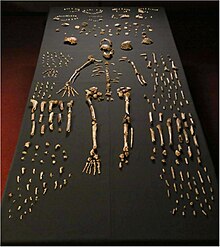
Back Homo naledi Afrikaans هومو ناليدي Arabic Homo naledi Azerbaijani Homo naledi BCL Homo naledi Byelorussian Homo naledi Catalan Homo naledi CEB Homo naledi Czech Homo naledi Welsh Homo naledi Danish
| Homo naledi Temporal range: Middle Pleistocene
| |
|---|---|

| |
| The 737 known elements of H. naledi | |
| Scientific classification | |
| Domain: | Eukaryota |
| Kingdom: | Animalia |
| Phylum: | Chordata |
| Class: | Mammalia |
| Order: | Primates |
| Suborder: | Haplorhini |
| Infraorder: | Simiiformes |
| Family: | Hominidae |
| Subfamily: | Homininae |
| Tribe: | Hominini |
| Genus: | Homo |
| Species: | †H. naledi
|
| Binomial name | |
| †Homo naledi Berger et al., 2015
| |

| |
| Location of Rising Star Cave in the Cradle of Humankind, South Africa | |
Homo naledi is an extinct species of archaic human discovered in 2013 in the Rising Star Cave system, Gauteng province, South Africa (See Cradle of Humankind), dating to the Middle Pleistocene 335,000–236,000 years ago. The initial discovery comprises 1,550 specimens of bone, representing 737 different skeletal elements, and at least 15 different individuals. Despite this exceptionally high number of specimens, their classification with other Homo species remains unclear.
Along with similarities to contemporary Homo, they share several characteristics with the ancestral Australopithecus as well as early Homo (mosaic evolution), most notably a small cranial capacity of 465–610 cm3 (28.4–37.2 cu in), compared with 1,270–1,330 cm3 (78–81 cu in) in modern humans. They are estimated to have averaged 143.6 cm (4 ft 9 in) in height and 39.7 kg (88 lb) in weight, yielding a small relative brain size, encephalization quotient, of 4.5. H. naledi brain anatomy seems to have been similar to contemporary Homo, which could indicate comparable cognitive complexity. The persistence of small-brained humans for so long in the midst of bigger-brained contemporaries revises the previous conception that a larger brain would necessarily lead to an evolutionary advantage, and their mosaic anatomy greatly expands the known range of variation for the genus.
H. naledi anatomy indicates that, although they were capable of long-distance travel with a humanlike stride and gait, they were more arboreal than other Homo, better adapted to climbing and suspensory behaviour in trees than endurance running. Tooth anatomy suggests consumption of gritty foods covered in particulates such as dust or dirt.
Although they have not been associated with stone tools or any indication of material culture, they appear to have been dexterous enough to produce and handle tools, and therefore may have manufactured Early or Middle Stone Age industries found in excavations near their fossils, since no other human species in the vicinity at that time has been discovered. It has also been controversially postulated that these individuals were buried deliberately by being carried into and placed in the chamber. Some researchers suggest that H. naledi also may have carved crosshatched rock signs in a passage to what could be a burial chamber, but many paleontologists question this theory.